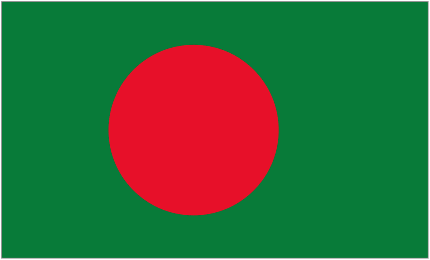- Population: 152.6 million (UN, 2005)
- Capital: Dhaka
- Area: 143,998 sq km (55,598 sq miles)
- Major language: Bengali
- Major religions: Islam, Hinduism
- Life expectancy: 62 years (men), 63 years (women) (UN)
- Monetary unit: 1 taka = 100 paisa
To the world, Bangladesh is layered with strips of identity of what is one of the poorest nations in the planet. George Harrison renders a song of sympathy “Bangladesh” to this country of such distress where “people die fast.” The world can’t help looking at this South Asian country in that manner when a good news story is so hard to come by. Half of the population of Bangladesh live on less than a dollar a day. In the midst of politically-motivated violence and kidnapping, carrying on the normal stuff of life proves to be both tricky and difficult, to say the least.
GEOGRAPHY & CLIMATE
The People’s Republic of Bangladesh has a total area 143,998 km2 that centrally lies on the geographic coordinates 24 00 N, 90 00 E. In one of the most densely populated places in the world, it’s hard to imagine there’s any more room for nature. Then you witness a special relationship between the two. The “poor” country, or so they say, has a terrain that is mostly flat alluvial plans with some hilly slopes in the lower east, and, with a tropical climate, to add has a rich arable land that outlines 55.39% of the country. The highest point in the country is the Keokradong, with an elevation of only 1230 metres, and the lowest thus, Indian Ocean, 0 metres elevation. The climate, being tropical, summers from the month March to June are both very hot and humid, the monsoons from June to October are wet, though also warm and humid, while winters from October to March are just mild. SO generally, the conditions for living are spot on, if one has enough money. But as most people do not, the Bengalis are forced to thrive on lands stricken by either cyclones or droughts that nobody owns. Potable water is also far from abundant here with naturally occurring arsenic poisoning rivers.
PEOPLE & CULTURE
The Bengali population numbers at 156,050,883, making Bangladesh the 7th largest country in the world in terms of population. Bangladeshi and Bengali are the official names for the nationals of the country. Bengali also refers to the country’s major ethno-lingustic group and official language. The majority of the Bengali, particularly 89.7% (or more over 130 million) lives by the Islam faith, the state religion, and 9.2%, by Hinduism. The rest (Buddhists, 0.7%; Christians, 0.3%; and Animists, 0.1%) comprise just a tiny proportion. With ethnicities fractioned by language, the 98% of the population account for the statistics of both the population and the speakers of Bengali (Bangla) while the remainder are migrants and indigenous tribal groups. Bangla has been a part of the rich literary heritage of Bangladesh, in which the earliest literary text Charyapada, dated back to the 8th century is versed in. Despite being largely monolingual, there are more than 10 minor languages in the small country that is Bangladesh, i.e. Chittagonian, Sylheti, Urdu, and other tribal languages.
FOOD & ATTRACTION
The people you will meet in these parts are just cherries on top of a luscious destination sundae that is mostly unheard of and is yet to be hyped about in guide books. Beyond the capital Dhaka, within the flat landscape are fantastic national parks that resonate with the call of the Royal Bengal Tiger, the enigmatic hill tracts and hidden gems of Buddhist empires in Rangamati, the revered Shait Gumbad Masjid in Bagerhat, the lush green of tea gardens of Sylhet, and the vibrant corals of Saint Martin’s Island. The longest forever coast of Cox’s Bazar is also a salubrious destination, however just south of Chittagong, the site of recent political unrest and tourist abductions, caution must be taken.
Truly, Bangladesh has everything all at once, and a little too much. Famous Bengali leisure time activities involve playing Kabbadi, the national sport. But Bangladesh is one with the world as a football and cricket nation, the most popular sports.
Bengalis also love their food, and is one hobby they surely enjoy when they are not playing cricket, although with poverty daunting the country, a folk is glad to have eaten one meal in the day. The Bangladeshi cuisine also arouses curious interest from its visitors, and sure enough pleases its visitors who have monetary capacity to do so. Food is regionally varied by and large, but rice and curry are among the staples. Spices are lavishly used as these are basic components, turmeric, coriander, and chilies more than the rest. Bangladeshi cuisine is exceptionally similar to Indian cuisine with a hint of Central Asia. Unlike in Indian cuisine, beef is integral to the cuisine except among the Hindu minority. Fish are abundant in the country as well as bananas, oranges, apples, grapes, pomegranate, papaya, jackfruit, and the mangoes, “super fruit,” that are ample and assorted in kind.
The desserts in Bangladesh? Dude, sweet, of course! The Bengalis are a group of people with a sweet tooth whose cuisine has rich traditions in sweet making. Among the MUST-TRY are roshogolla, mishti doi, chomchom, payesh, and the national darlng, shondesh.






Leave A Response